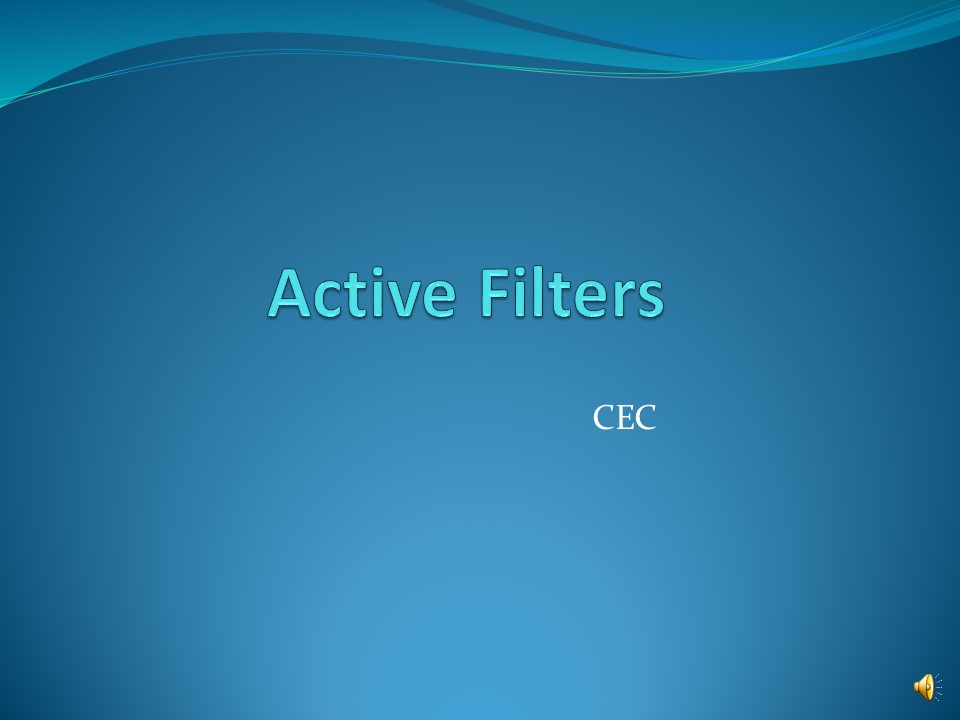Active Filters. PowerPoint PPT Presentation
Title: Active Filters.
1
Active Filters
- CEC
2
Contents
- Passive vs Active Filters.
- Active Low Pass Filter.
- Active High Pass Filter.
- Active Band Pass Filter.
- Active Band Reject Filter.
- State Variable Filter.
- FLT-U2 Universal Active Filter.
3
(No Transcript)
4
Active Filters
- A frequency selective circuit.
- Passes a specified band of frequencies (Pass
Band). - Blocks/attenuates signals of frequencies outside
the pass - band (Stop Band).
- Active or Passive?
- Active uses passive and active components
(such as - transistors, OPAMPs etc.), provides
amplification. - Inductors do not add to the bulk.
- Gain flexibility.
- Power supply requirements.
- Passive uses only passive electronic
components, no - amplification.
- Signal attenuation, No gain flexibility.
- Advantage Active Filters.
5
Active and Passive Components
Only Passive Components
OPAMP
Gain. No loading effect.
6
Classification of Filters
- Based on Frequency
- Low Pass Filter.
- High Pass Filter.
- Band Pass Filter.
- Band Elimination/Band Stop/Band Reject Filter.
Based on Pass Band/Stop Band Characteristics
- Butterworth Filter - Flat Pass Band, Flat Stop
Band. - Chebyshev Filter Flat Pass Band, Stop Band
Ripple. - Cauer Filter Pass Band Ripple, Stop Band
Ripple. etc
7
Sharp Cut Off
Pass Band
Stop Band
Pass Band
Stop Band
X Axis Frequency/Angular Frequency (Hz) Y Axis
Gain (dB)
Stop Band
Stop Band
Stop Band
Pass Band
Pass Band
Pass Band
8
Practical Filter Response
Roll off (dB/decade)depends on filter order.
A(dB)
A(dB)
fL
fH
fL
fH
- Cut Off Frequencies.
A(dB)
A(dB)
fH
fL
fH
fL
9
Filter Comparison
10
Active Filters
Contain active components such as operational
amplifiers, transistors or FETs within their
circuit design. Draw power from external power
source and use it to boost or amplify the output
signal. Generally used in communication and
signal processing i.e. radio, television etc.
Advantage of Active Filters over Passive Filters
- Gain and frequency adjustment flexibility.
- No loading problem (because of high i/p and low
o/p resistance of op-amp). - Cheaper than passive filters no use of
inductors. - Minimum/No use of inductors, hence less bulky.
11
First Order Low Pass Filter
Fig.1 Circuit Diagram
Fig.2 Frequency Response
Gain Flexibility. High Input Impedance. Low
Output Impedance.
OPAMP in non-inverting configuration does not
load down the RC Network.
12
- Gain of First Order Low Pass Filter
- where
- AF the pass band gain of the filter, (1
R2/R1) - ƒ the frequency of the input signal in
Hertz, (Hz) - ƒc the cut-off frequency in Hertz, (Hz)
- From the frequency gain equation above,
- At very low frequencies, ƒ lt ƒc
- At the cut-off frequency, ƒ ƒc
- At very high frequencies, ƒ gt ƒc
13
Designing a Low Pass Filter
- Choose a value of high cut off frequency ƒc
- Choose a value of C less than or equal to 1µF. A
mylar or tantalum capacitor is recommended
for better performance. - Calculate
- 4. Select R1 and R2
- AF the pass band gain of the filter, (1
R2/R1)
14
Second Order Low Pass Filter
Fig 2. Blue line shows frequency response of 2nd
order low pass filter.
Fig 1. Circuit Diagram
Higher Roll Off, Sharper Cut Off
15
Filter design for 2nd Order Low Pass Filter
- Choose a value of high cut off frequency ƒc
- To simplify the design set R2 R1 R and C1 C2
C then choose C less than - or equal to 1µF
- Calculate
- 4. AF the pass band gain of the filter, (1
Ra/Rb) 1.589
16
First Order High Pass Filter
Fig 1 Circuit Diagram
Fig 2 Frequency Response
17
- Gain of First Order Active High Pass Filter
- where
- AF the pass band gain of the filter, (1
R2/R1) - ƒ the frequency of the input signal in
Hertz, (Hz) - ƒc the cut-off frequency in Hertz, (Hz)
- From the frequency gain equation above,
- At very low frequencies, ƒ lt ƒc
- At the cut-off frequency, ƒ ƒc
- At very high frequencies, ƒ gt ƒc
18
Second Order High Pass Filter
Fig 1. Circuit Diagram
Fig 2. Red line shows the frequency response of
2nd order
Higher Roll Off, Sharper Cut Off
19
Wide Band Pass Active Filter
fH
fL
fH gt fL
Design HPF for fL
Design LPF for fH
20
Narrow Band Pass Active Filter
Feedback Paths
C1 C2 C
Multiple Feed back Filter
fc vf1.f2
21
f0
22
Band Pass Filter Response and Q Factor
f0
23
Formula for Q Factor
f0 vf1.f2
24
Wide Band Reject Filter
Block Diagram
25
Notch Filter
Voltage Follower
Used to eliminate power supply hum.
26
State Variable Filters
R5
In
A1
A2
A3
LPO
Low Pass Filter
High Pass Filter
Band Pass Filter
Also called Universal Active Filters.
27
FLT-U2 Universal Active Filter
User has flexibility to be configure as a filter
or as a buffer.
User Preference
A1
A2
A3
A4
External Passive Filter Components to be
connected to the chip, A4 can be wired by the
user.
28
References
- Roy D. C. and S. B. Jain, Linear Integrated
Circuits, New Age International, 3/e, 2010.
2. Your Prescribed Text Books and Online
References.
29
Keep Learning

